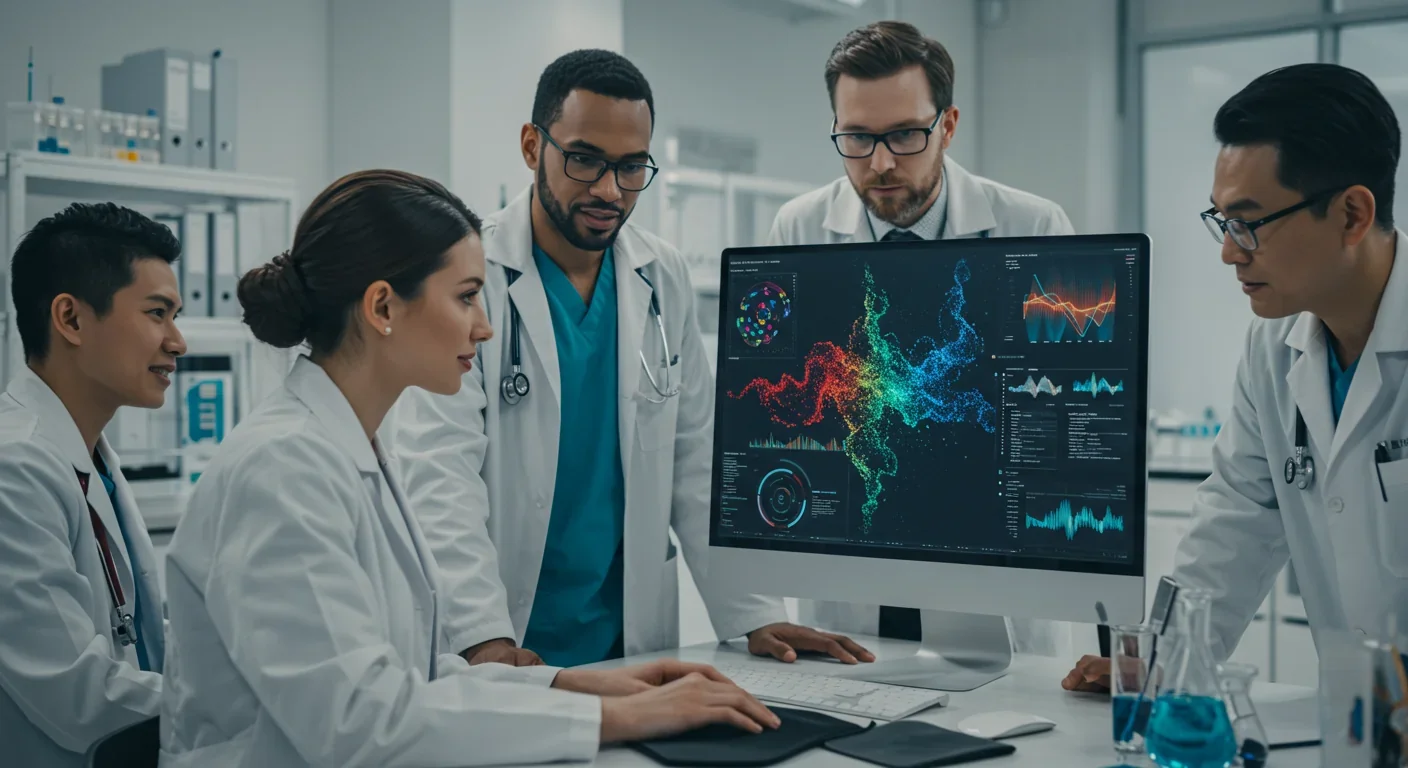Epigenetic Clocks Predict Disease 30 Years Early

TL;DR: AI systems now predict disease risk decades in advance by analyzing genomic data, slashing diagnostic time and boosting accuracy by 35%. As this $100 billion industry reshapes healthcare from reactive to predictive, society faces urgent questions about data privacy, algorithmic bias, and equitable access.

Within the next five years, your doctor might predict your risk of developing cancer decades before symptoms appear. Not through crystal balls or elaborate medical testing, but by feeding your genetic code into an artificial intelligence system that learned from millions of other patients. This isn't speculation anymore. In 2024, researchers unveiled Delphi-2M, an AI trained on data from 400,000 participants that accurately forecasts disease risk for over 1,000 conditions up to 20 years in advance. It's the beginning of a quiet revolution where algorithms know your body's future better than you do.
Picture this: a machine analyzes billions of data points from your genome, medical history, lifestyle choices, and even social determinants like where you live and what you eat. Within hours, not weeks, it identifies patterns invisible to human clinicians and generates a personalized health roadmap. That's AI-driven genomic analysis today.
The machinery behind this transformation relies on deep learning models, particularly generative transformers similar to those powering ChatGPT. These systems digest medical histories as sequences of events unfolding through time: diagnoses based on ICD-10 codes, lifestyle factors like smoking and alcohol use, body mass measurements, and mortality outcomes. They learn how diseases develop, what precedes them, when risks emerge.
Next-generation sequencing costs plummeted from millions of dollars per genome two decades ago to under $600 today. AI accelerates that data processing further, cutting turnaround times from weeks to days in many clinical applications. Advanced algorithms now achieve 35% higher diagnostic yield compared to manual interpretation, with machine learning models predicting disease risk with over 85% accuracy for certain conditions.
Take RNA sequencing. Unlike DNA, which reveals your genetic blueprint, RNA captures what your genes are actually doing right now. Tempus recently received FDA clearance for an AI-enabled RNA sequencing diagnostic device that detects gene rearrangements linked to cancer. RNA data exposes molecular pathways directly involved in disease progression, giving AI models richer inputs for identifying therapeutic targets.
The result? Physicians can now spot which cancers will respond to specific drugs, which patients face elevated cardiovascular risk, or who needs preventive interventions years before symptoms manifest.

The genome sequencing market reached $22.63 billion in 2024 and is projected to hit nearly $102 billion by 2034, growing at 16.24% annually. That explosive growth is fueled by AI's ability to make sense of complex genomic data at scale.
Consider oncology, where AI now spans the entire workflow: image-based screening, pathological diagnosis, intelligent decision support, treatment outcome prediction, and personalized therapy design. The rapid adoption stems from three converging forces: proliferation of large-scale datasets, breakthroughs in computational hardware and algorithms, and innovative deep learning architectures.
Real-world clinical trials are validating these tools. Studies integrating social determinants of health with AI models show significant advances in cancer diagnostics, treatment planning, and survival prediction. AI-driven radiomics and histopathology enhance early detection, particularly in underserved populations. By analyzing electronic health records, geographic information systems, and real-world trial data using machine learning, natural language processing, and explainable AI techniques, researchers can stratify patients by risk and tailor interventions accordingly.
The United Kingdom's Delphi-2M model, trained on UK Biobank participants and validated on 1.9 million Danish patients, demonstrated that generative models can learn long-term health trajectories across diverse populations. The model achieved its highest predictive success for diseases with clear, consistent progression patterns: specific cancers, heart attacks, septicemia. Mental health disorders and pregnancy-related complications proved more difficult, revealing current limitations.
Clinicians are cautiously optimistic. "By modeling how illnesses develop over time, we can start to explore when certain risks emerge and how best to plan early interventions," says Ewan Birney, interim executive director at EMBL. Moritz Gerstung, head of the division of AI in oncology at DKFZ, frames it as "the beginning of a new way to understand human health and disease progression."
If AI can predict your diseases decades ahead, what happens when insurance companies want access to those predictions? What if employers do?
The ethical landscape is treacherous. Privacy regulations like GDPR and HIPAA govern how genomic data is handled, but enforcement remains patchy across borders. Data breaches could expose your most intimate biological secrets. Worse, AI systems trained on biased datasets perpetuate inequities. Delphi-2M's training data came predominantly from people aged 40 to 60, with certain ethnic groups underrepresented. That creates algorithmic blind spots, reducing accuracy for younger and diverse populations who need precision medicine most.
Critics warn about "data colonialism" where external actors extract genomic data from populations in low- and middle-income countries without reciprocal benefit, consent, or local control. AI can either narrow or widen health inequities depending on how inclusive data practices, equitable governance, participatory design, and local capacity-building are integrated.
Then there's interpretability. Deep learning models are notoriously opaque. When an algorithm flags you as high-risk for a disease, can your doctor explain why? Explainable AI techniques like SHAP and LIME provide visual explanations showing which genomic features influenced predictions. But many clinicians remain skeptical of trusting "black box" systems for life-or-death decisions.
The bibliometric analysis of AI in medical risk prediction shows that interpretability, privacy, ethics, reliability, and standardization remain the main barriers to widespread adoption. Publications on AI in medicine exploded post-2020, but the United States and China dominate research output, and many researchers work in isolation, slowing translational progress.
Bias mitigation strategies exist: privacy-by-design frameworks, federated learning that trains models across institutions without sharing raw data, diverse datasets, and dynamic ethical oversight. But implementing them consistently across the healthcare ecosystem? That's the hard part.

Personalized medicine powered by AI represents more than technological progress. It's a fundamental rethinking of healthcare from reactive to predictive, from population averages to individual precision.
Historically, medicine has treated everyone with the same condition similarly. Statins for high cholesterol. Chemotherapy for cancer. One-size-fits-all protocols based on clinical trials that averaged outcomes across thousands of patients. AI flips that model. It asks: what works specifically for you, given your unique genetic makeup, environment, and life circumstances?
The implications ripple outward. If we can predict Alzheimer's risk 20 years ahead, should we? Some people want to know so they can plan their lives accordingly. Others would rather not live under that shadow. Who decides? And if preventive interventions exist, who pays for them? Health systems already strain under current costs. Scaling personalized medicine globally requires massive investment in infrastructure, training, and equitable access.
Different cultures approach these questions differently. In East Asian countries with centralized health databases and less stringent privacy norms, AI adoption in healthcare is accelerating rapidly. China leads in research output volume alongside the United States, leveraging vast population data to train ever more sophisticated models. European nations prioritize data protection and patient consent, slowing deployment but building more robust ethical frameworks. The U.S. fragments across a patchwork of private insurers, research institutions, and regulatory agencies, creating innovation but also inequality.
India and Africa are testing AI-powered tools adapted to local contexts. In India, the REAN Foundation developed an AI chatbot for non-invasive anemia screening during pregnancy. In Ghana, mobile health technologies support diagnosis, treatment, and communication in maternal health settings. These innovations show AI's potential in resource-constrained environments, though data ownership and local capacity remain concerns.
International cooperation on standards and governance is minimal. Who validates AI models for safety before clinical use? The FDA cleared Tempus's RNA sequencing device, but regulatory pathways differ globally. Without harmonization, we risk a chaotic landscape where AI diagnostics approved in one country are banned in another, or worse, deployed without adequate oversight.
So what do you do with all this? How do you prepare for a world where your genome becomes your medical roadmap?
First, understand that AI-driven personalized medicine isn't science fiction anymore. It's arriving incrementally. Your next cancer screening might incorporate AI analysis. Your pharmacist might consult an algorithm to tailor drug dosages to your genetics. Insurance forms might soon ask if you've had genomic risk assessments.
Stay informed about data privacy. Know who has access to your genetic information and under what terms. Push for policies that protect genomic data as rigorously as financial records. Support regulations requiring explainable AI in healthcare so you understand why an algorithm makes recommendations about your body.
Advocate for diverse datasets. If AI models aren't trained on people like you, they won't work for you. Clinical trials and biobanks must prioritize inclusivity across age, ethnicity, gender, and socioeconomic status.
Engage with your healthcare providers. Ask if AI tools are being used in your care and how. Request explanations. Good doctors will welcome these conversations because they're navigating this transformation too.
Build health literacy. The more you understand about genomics, probability, and risk stratification, the better equipped you'll be to interpret AI-generated insights. A 40% lifetime risk of a disease doesn't mean certainty. Context matters. Preventive actions can shift odds dramatically.
Finally, participate in the debate. Personalized medicine will reshape society whether we plan for it or not. Will it reduce health disparities or entrench them? Extend lives equitably or only for the wealthy? Empower patients or create new forms of discrimination? The answers depend on choices we make now about regulation, access, and values.
By 2034, the genome sequencing market will be worth over $100 billion. AI will analyze not just your DNA and RNA, but your microbiome, metabolome, proteome, and exposome in an integrated, multimodal approach. Drugs will be designed computationally before they're tested in labs. Tools like AlphaFold predict protein structures with stunning accuracy, enabling precision drug design impossible a decade ago.
We're transitioning from "sick care" to "health care" in the truest sense: maintaining wellness rather than merely treating illness. The question isn't whether AI will transform medicine. It already has. The question is whether that transformation will be just.
Ewan Birney's words echo: "By modeling how illnesses develop over time, we can start to explore when certain risks emerge and how best to plan early interventions." But planning interventions requires political will, funding, ethical frameworks, and public trust. Technology provides tools. Society decides how to wield them.
Imagine receiving a health report at age 30 showing elevated risk for cardiovascular disease at 50. You adjust your diet, exercise routine, and stress management. At 50, your heart is healthier than predicted. That's the promise: agency over your biological destiny. But if that same report leads to job discrimination or insurance denial, the promise becomes a curse.
We're at an inflection point. AI can read the book of your genome and predict your body's future chapters. Now we must write the rules governing who gets to read that book, what they can do with the information, and how we ensure everyone benefits from this astonishing science. The age of personalized medicine has arrived. What we do with it will define the next era of human health.

Recent breakthroughs in fusion technology—including 351,000-gauss magnetic fields, AI-driven plasma diagnostics, and net energy gain at the National Ignition Facility—are transforming fusion propulsion from science fiction to engineering frontier. Scientists now have a realistic pathway to accelerate spacecraft to 10% of light speed, enabling a 43-year journey to Alpha Centauri. While challenges remain in miniaturization, neutron management, and sustained operation, the physics barriers have ...

Epigenetic clocks measure DNA methylation patterns to calculate biological age, which predicts disease risk up to 30 years before symptoms appear. Landmark studies show that accelerated epigenetic aging forecasts cardiovascular disease, diabetes, and neurodegeneration with remarkable accuracy. Lifestyle interventions—Mediterranean diet, structured exercise, quality sleep, stress management—can measurably reverse biological aging, reducing epigenetic age by 1-2 years within months. Commercial ...

Data centers consumed 415 terawatt-hours of electricity in 2024 and will nearly double that by 2030, driven by AI's insatiable energy appetite. Despite tech giants' renewable pledges, actual emissions are up to 662% higher than reported due to accounting loopholes. A digital pollution tax—similar to Europe's carbon border tariff—could finally force the industry to invest in efficiency technologies like liquid cooling, waste heat recovery, and time-matched renewable power, transforming volunta...

Humans are hardwired to see invisible agents—gods, ghosts, conspiracies—thanks to the Hyperactive Agency Detection Device (HADD), an evolutionary survival mechanism that favored false alarms over fatal misses. This cognitive bias, rooted in brain regions like the temporoparietal junction and medial prefrontal cortex, generates religious beliefs, animistic worldviews, and conspiracy theories across all cultures. Understanding HADD doesn't eliminate belief, but it helps us recognize when our pa...

The bombardier beetle has perfected a chemical defense system that human engineers are still trying to replicate: a two-chamber micro-combustion engine that mixes hydroquinone and hydrogen peroxide to create explosive 100°C sprays at up to 500 pulses per second, aimed with 270-degree precision. This tiny insect's biochemical marvel is inspiring revolutionary technologies in aerospace propulsion, pharmaceutical delivery, and fire suppression. By 2030, beetle-inspired systems could position sat...

The U.S. faces a catastrophic care worker shortage driven by poverty-level wages, overwhelming burnout, and systemic undervaluation. With 99% of nursing homes hiring and 9.7 million openings projected by 2034, the crisis threatens patient safety, family stability, and economic productivity. Evidence-based solutions—wage reforms, streamlined training, technology integration, and policy enforcement—exist and work, but require sustained political will and cultural recognition that caregiving is ...

Every major AI model was trained on copyrighted text scraped without permission, triggering billion-dollar lawsuits and forcing a reckoning between innovation and creator rights. The future depends on finding balance between transformative AI development and fair compensation for the people whose work fuels it.